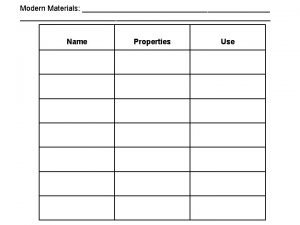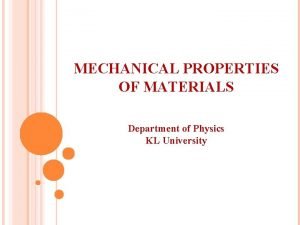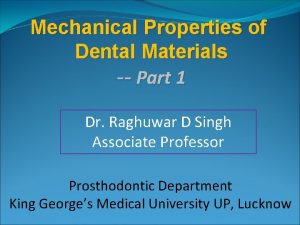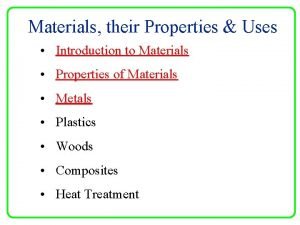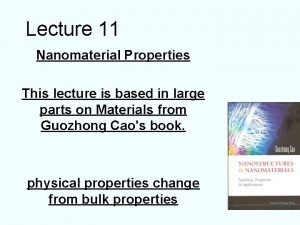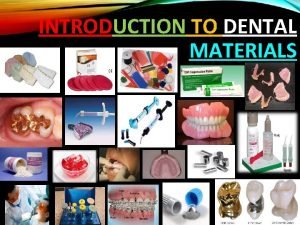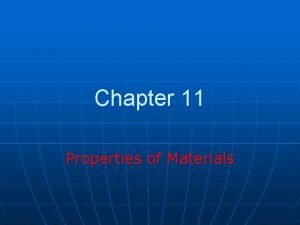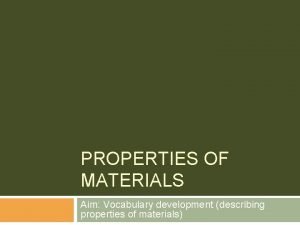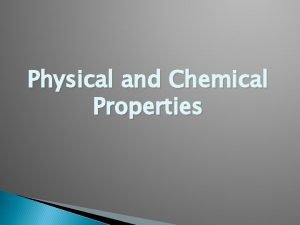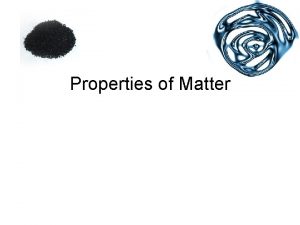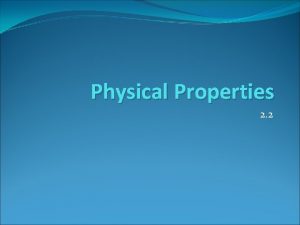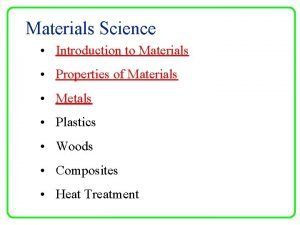Physical Properties of Materials Physical Properties of Materials















- Slides: 15

Physical Properties of Materials

Physical Properties of Materials • All objects are made of matter. • Matter is anything that has mass and takes up space. • Kinds of matter can include a sugar cube, a drop of water, helium gas inside a balloon, etc.

Matter • Click the picture below to learn more about matter.

Physical Properties of Matter • A physical property is a feature that you can observe with your senses or measure with a tool. • Physical properties are observed without changing a substance into a different kind of matter.

Color and Texture • Color and texture are physical properties. You use your sense of sight and touch to observe these. • For example, iron is dark gray while copper is brownish orange. You can tell the difference between these metals by their color. • Examples of textures include rough, bumpy, smooth, waxy, soft, powdery, greasy, etc.

Sound, Smell, and Taste • Sound, smell, and taste are also physical properties. You can use your senses to observe these. Sound Smell Taste You can tell the difference between types of matter by the sound they make when manipulated. You could smell a kind of matter to identify it. Sugar and salt look similar, but a taste will tell you which is which.

How Substances Act: Conductivity • Some physical properties describe how a substance acts. • You can observe how a substance conducts (transfers) heat. Good conductors allow heat to pass through easily. • Good conductors include metals such as iron, copper, and silver. Heat and Electricity Conductivity Game

How Substances Act: Magnetism • Magnetism is a physical property that can be observed. You would use a magnet to test if a substance is magnetic. • Iron, nickel, and cobalt are all metals that a magnet attracts. Since steel is made with iron, magnets attract it as well. • A magnet will not attract glass, wood, plastic, or rubber. Magnetism Game Click to watch a Magnetism Demonstration

How Substances Act: Solubility • A substance’s ability to dissolve is also a physical property. To dissolve is to mix evenly in a liquid. Click below to watch salt dissolve in water. • Both sugar and salt can dissolve in water. Click to play a Solubility Game • Many substances such a sand metal will NOT dissolve in water.

States of Matter • Recall that matter can be a solid, a liquid, or a gas. • Matter can change forms by being heated or cooled. • For example, heat can make ice melt. When ice melts, it changes from a solid to a liquid.

States of Matter • Click the picture below to review states of matter.

Physical Properties You Can Measure • Temperature is measured with a thermometer. You can use Fahrenheit or Celsius to measure temperature. • Mass (the amount of matter that makes up an object) can be measured with a pan balance. • Weight (the measure of the pull of gravity on an object’s mass) can be

Mass and Weight • An object’s mass and weight can be measured in grams and kilograms. • Although mass and weight mean different things, their measure is about the same on Earth because of Earth’s Gravity.

Apart and Together • The weight of an object is equal to the weight of all of its parts together. • For example, a model car weighs 20 grams. If you take the model car apart and weigh it’s parts together, it will still be 20 grams. 20 g

Let’s Review • Click the pictures below to review properties of matter.
 Chemical properties of dental materials
Chemical properties of dental materials Grade 7 ns term 2
Grade 7 ns term 2 Chemical property of matter
Chemical property of matter Cant stop the feeling go noodle
Cant stop the feeling go noodle Can useful materials be harmful
Can useful materials be harmful Natural man made
Natural man made Adopting materials
Adopting materials Direct materials budget with multiple materials
Direct materials budget with multiple materials Stomatex fabric
Stomatex fabric Ductility
Ductility Stress strain curve toughness
Stress strain curve toughness Malleability
Malleability Hardness of nanomaterials
Hardness of nanomaterials Auxillary dental materials
Auxillary dental materials Properties of materials examples
Properties of materials examples Properties of materials vocabulary
Properties of materials vocabulary








